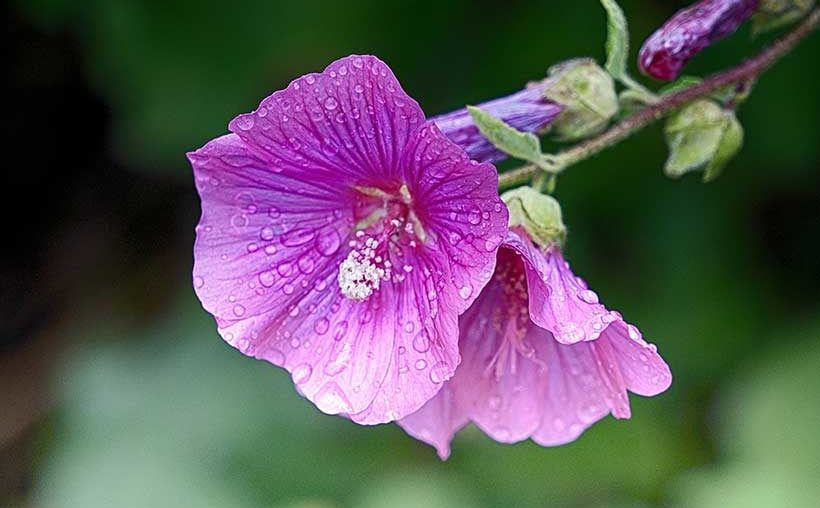The hollyhock, also called papal rose, is a flower of the family Malvaceae. Known for its country charm, it embellishes all the gardens that house it. When and how to sow the hollyhock on its land? We tell you everything in this article!
When to sow the hollyhock?
The hollyhock usually sown between September and May. However, it is best to avoid frost and other bad weather. So, the right time to sow can vary considerably according to geographical areas.
For example, if you live in an area where the climate is cold and wet, it will be advisable to plant the hollyhock at the end of winter, or the arrival of spring. However, if you live in a Mediterranean place, you can sow the hollyhock perfectly during the autumn, or during particularly mild winters.
The flowering the hollyhock is about one year after the first plantation. You will be able to observe the first flowers in your garden the year after the planting of your seedlings.
What varieties of hollyhock favor?
There is no less than one sixty different varieties of hollyhock. Each of them benefits from specificities. Among this long list, it is naturally difficult to find the one that suits you best. Here are some that may interest you …
The Alcea Rosea called "Nigra" is characterized by its dark flowers. If you want to get a beautiful bloom in shades of chocolate, do not hesitate to opt for this variety! This species of hollyhock is ideal for a chic and sober garden.
Want bright colors? The Alcea Rosea called "chater's double" may seduce you. This variety produces flowers with double pompoms in various colors such as white, yellow, pink or purple. That's enough to brighten up your garden!
What to do before sowing the hollyhock?
To obtain a beautiful plantation of hollyhock, it is important to prepare the soil well. The first step is to choose the ideal location for your seedlings. The hollyhock grows particularly well in bright and sunny placesbut slightly sheltered from the wind. They also appreciate the curbs and feet of low walls to grow along these.
The soil that will welcome the hollyhock must be rich and well drained. It is therefore important to make it more fertile by using fresh compost and river sand a few weeks before sowing. Also remember to weed the area deep to allow maximum space for your plant. It is also recommended to rake to effectively level the ground.
Be careful, the hollyhock is not suitable for growing in pots. It will be necessary to wait until the ideal moment to sow it in the garden, in the ground, with a little soil to decorate.
How to sow the hollyhock?
The hollyhock is sown directly in feet. It is recommended to leave a space of at least 30 centimeters between each foot. It is possible to put 2-3 feet per location. It is also possible to sow your seeds on the fly for a more natural result.
Cover it with a thin layer of soil, to which you can add a little potting soil. Remember to moisten everything with a few drops of water. Be careful not to move the seeds by watering too hard. Note that the earth should never be deeply dry. It will therefore be necessary to water regularly your plantation, especially in hot weather.
On a daily basis, think about remove the faded flowers. This will stimulate the growth of new flowers. At the end of the season, you can also cut the stems. These will grow back naturally, in better health. During cold weather, it is possible to protect the feet of your flowers using mulching. If the winds are strong, it may be necessary to stanch your roses to protect them from the weather, and allow them to grow in the best way.
Spot diseases of the hollyhock
Like any plant, the hollyhock can get sick. It is important to know the ills that can affect your hollyhocks in order to react quickly, and overcome them.
Among the most famous diseases in this flower, we find rust. The latter appears in wet weather, in spring or autumn. It is mainly manifested by yellowish spots on the leaves. These can even perforate the plant. They end up darkening, and drop the petals. Faced with this contagious disease, it is possible to apply on your roses Bordeaux mixture. This special gardening blend is known to combat many diseases. It can also be used preventively!
The hollyhock is also not immune to aphid attacks. Indeed, these small insects particularly enjoy nibbling the garden plants. Often in numbers, they can annihilate an entire plantation if they are not hunted in time. If your hollyhocks are eaten by aphids, they will not curl up and become sticky. To avoid this kind of inconvenience, it is important to invest in natural anti-insect treatments.
How to use the hollyhock?
Unquestionably, the hollyhock beautifies any place. In a very country style, it enchants the walls of the gardens. Most people are content with their aesthetic appearance. It should be noted however that the hollyhock also has medicinal properties!
Indeed, it is known by followers of herbal medicine for its soothing and relaxing benefits. It is possible to use herbal tea as anti-stress, or to fight against insomnia. It is also useful for soothing ailments related to the upper respiratory tract and mucous membranes.
Please note that the hollyhock is also edible ! It is possible to eat it in fresh salad or leather like a vegetable. But be careful not to have chemical treatment on your plants. If this is the case, it is best not to eat them.
To go further in the plantation:









